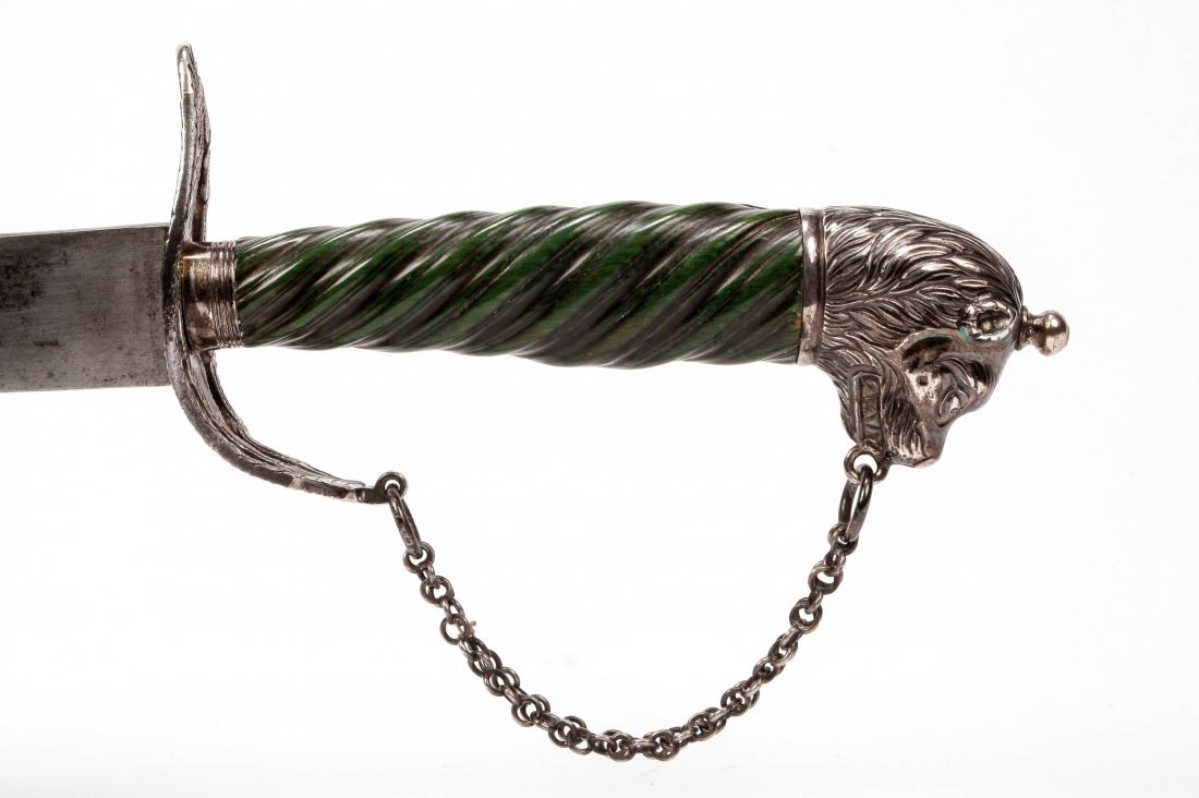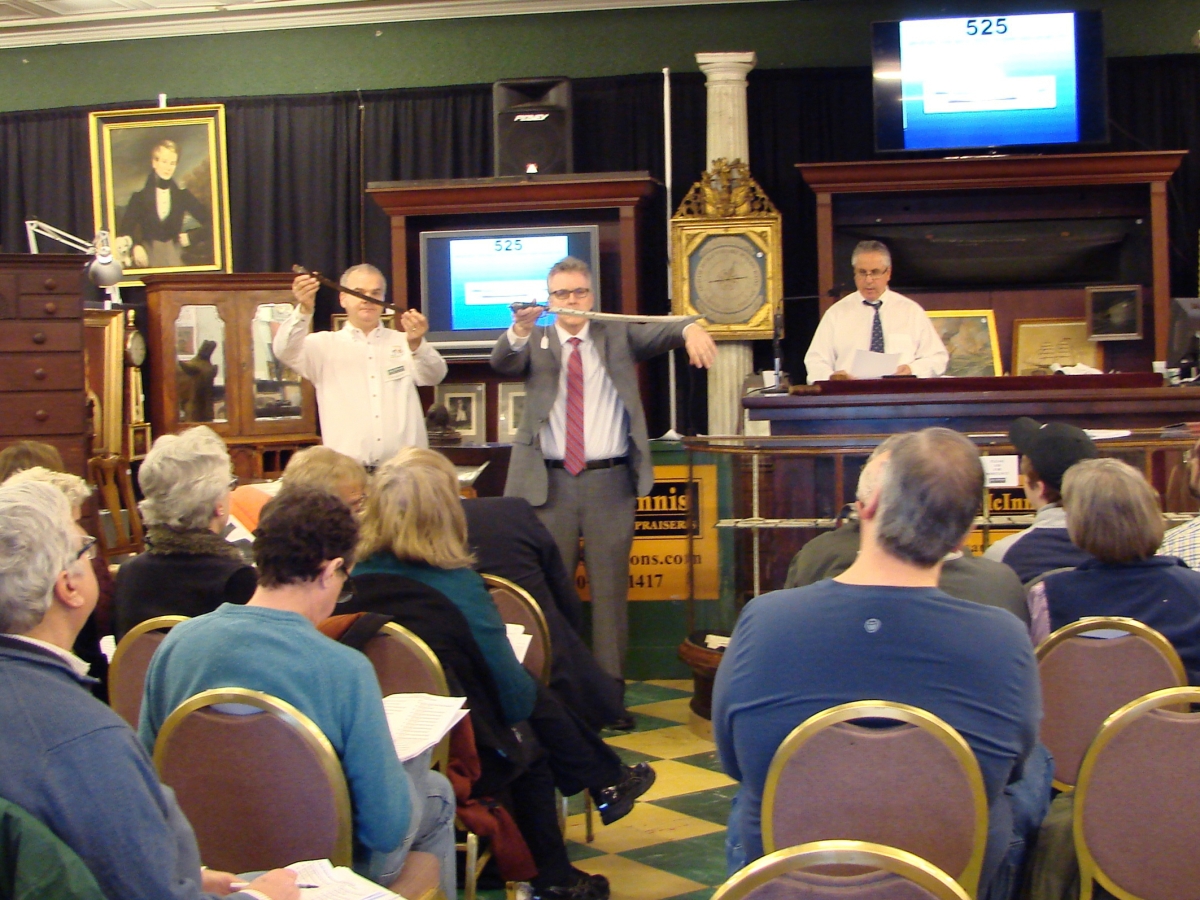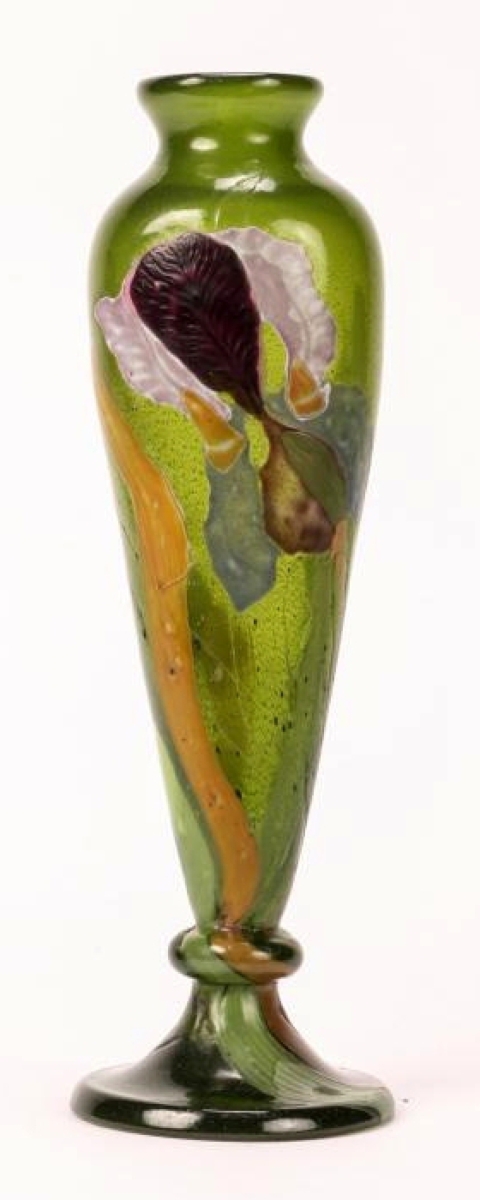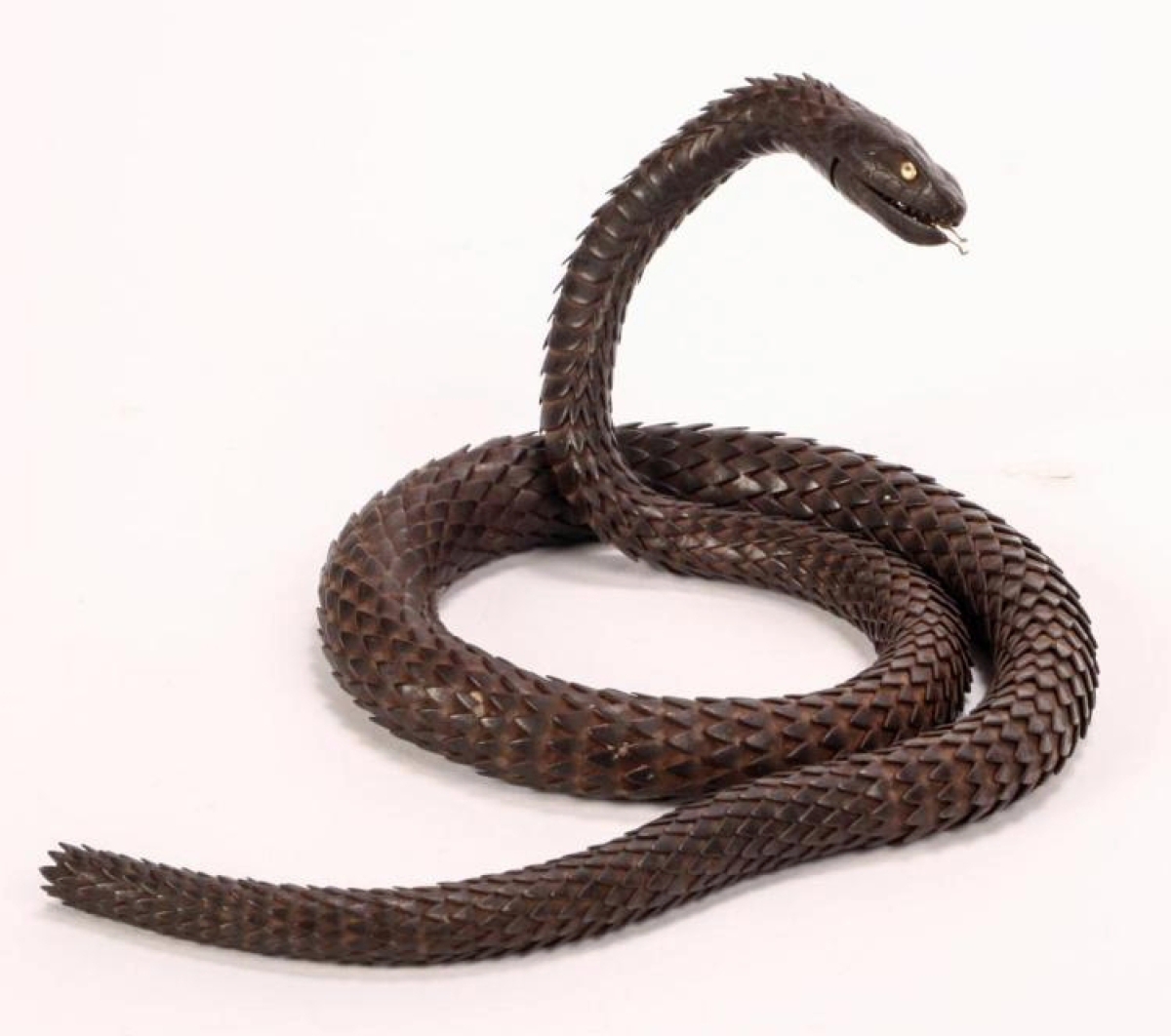
At $102,000, a sword made by silversmith and cutler John Bailey, dated 1777, was expected to be the highest priced item in the sale and it was. It had an engraved mount indicating that it had belonged to Francis Dana, a very active figure before, during and after the Revolutionary War. It had remained in the family until offered in this sale.
Review And Onsite Photos By Rick Russack, Photos Courtesy of John McInnis Auctioneers
AMESBURY, MASS. – John McInnis’s three-day spring estates auction, March 24-26, was a collection of collections. There were more than 25 cameras, including several Leicas, about 15 china and bisque dolls, some 70 lots of gold and silver coins, 75-plus pairs of coach and carriage lamps, dozens of lots of sleigh and harness bells, coaching prints and books – and that was just the first day.

John McInnis selling the John Bailey sword that brought $102,000. It is being shown to the bidders in the room, one of whom was the successful bidder.
The second day had about 35 lots of reverse paintings on glass, most with more than one example and 20-plus lots of silhouettes, again, most with more than one example. Also offered were a collection of bride’s boxes, Arthur Rackham first editions, numerous folk paintings, academic paintings, silver, clocks, American furniture and more. The third day included Asian items, Continental ceramics, European furniture and paintings, silver, jewelry, art glass, original renderings of jewelry designs by Edward Oakes and still more. All in all, about 1,400 lots were sold for a total $1.15 million. All but one of the major items sold. It was the kind of a sale where everyone went home happy – collectors, dealers, the auctioneer and the consignors.
McInnis was confident that he had a winner in the John Bailey Revolutionary War sword and he knew he had estimated it aggressively. His judgment was correct as a happy collector, who had come just for the sword, took it home, paying $102,000. The sword had been made by John Bailey, a silversmith and cutler who worked in New York City, but left in the early years of the war. Bailey made swords for Revolutionary War officers, including George Washington. That sword is now in the Smithsonian and another is owned by the Metropolitan Museum of Art.
The example in this sale, with Bailey’s distinctive lion head pommel, protruding snout and rows of exposed teeth, had belonged to Francis Dana, and remained in his family until being sold at this sale. The sword, dated 1777, was in fine condition, signed by the maker, engraved with Dana’s name and included most of its original leather scabbard, which was also signed.
Dana was an early member of the Sons of Liberty, a member of the Continental Congress, a signer of the Articles of Confederation, ambassador to Russia, assisted Washington with writing a plan to reorganize the Colonial army and served in diplomatic posts in Great Britain during the war and with John Adams negotiating the Treaty of Paris, ending the war. His list of postwar accomplishments is long and his descendants were noted authors.

One of the major surprises of the third day was this scarce Galle marquetry vase. It was just under 14 inches and partially gilt filled. An aggressive internet bidder kept jumping the bid by multiple thousands of dollars, but finally lost out to a phone bidder who paid $43,200, more than seven times the estimate.
This fully marked sword was considered by many to be the finest surviving example and the one with the most impeccable provenance. McInnis said that he got the consignment as a result of an estate appraisal. The consignment included other articles belonging to Dana, including bookplates engraved by silversmith Nathaniel Hurd. The bookplates were sold in lots of ten, most lots bringing a reasonable $330. A dealer in the room said that he had sold Hurd bookplates for as much as $500 each.
While on the subject of swords, McInnis sold another important one that was purchased by the USS Constitution Museum in the Charlestown Navy Yard, which is part of the Boston National Historical Park. It had belonged to Captain William Bainbridge, commander of the USS Constitution during the War of 1812 and later commander of the Charlestown Naval Yard. He also was active in battles with the Barbary pirates. Bainbridge’s sword, along with family letters, daguerreotypes and other belongings, sold for $8,400.
McInnis started the sale Friday evening with collections of cameras, German dolls, coins and a large coaching collection of carriage lamps, sleigh and other bells, coaching prints and books. The highlight among cameras was a Leica R4 camera body with Leitz Leica lenses and accessories that brought $1,320. A Leica 111G camera in a case with seven Leica lenses and accessories sold for $1,200. Most of the dolls sold under $200.
A collection of coach lamps and related items provided good buys for those interested. The approximately 75 pairs of lamps mostly sold for $75-$150 each, but a 22-inch pair by Cunningham earned $1,080 and a 26-inch pair with fancy candle font, made in Amesbury by Atwood Brothers, reached $570. The coaching prints, related books and large quantity of bells were not expensive.
Several coin dealers were present for the coins and they competed with phone and internet bidders. Selling for more than three times its estimate was a 1921-D walking Liberty half dollar, which realized $18,000. At least eight bidders competed for it. Competition was also strong for an 1876CC seated Liberty half dollar, which reached $5,100, also over estimate. McInnis did not publish grading, but his estimates were conservative and buyers made their own decisions. Gold coins were topped by a 1915 Indian head gold dollar at $1,920.
Lee Bellisario, Bellisario’s Rare Coin Gallery, Wellesley, Mass., bid on several lots of coins, including the 1921 walking Liberty half dollar. After the sale, he said, “This was a good group of material. It was fresh to the market and that always helps. The estimates were based on conservative grading, but dealers rely on their own judgment concerning condition. The market is in good shape today. Like everything else, it’s down from the prerecession levels, but there’s plenty of interest. The high end of the market is doing fine.”
A crowd of about 150 bidders was in the room for the second day of the sale, which included most of the Americana lots. The day started with an unsigned double folk art portrait of a mother and child in the manner of Ruth Shute, probably a postmortem. The mother, identified as Almira Slade Slocum, was dressed in a black gown and her son was in a white gown. The painting sold for $5,100.
The sale included a large collection of reverse paintings on glass and several brought higher than expected prices. Competition was strong and many sold to buyers in the room. A number of the paintings were of American presidents and a portrait of John Adams in a finely appointed interior earned $2,700. A portrait of Andrew Jackson on horseback reached $1,320 and a portrait of George Washington finished at $1,200. A lot with three presidential portraits, Washington, Jefferson and van Buren, ended up at $3,000.

Constructed of numerous iron plates, this fully articulated Myochin School snake was made in Japan during the Meji period. The head is realistically carved with scales and a hinged jaw, a removable gilt tongue and gilt eyes. It finished at $26,400.
A large group of silhouettes and miniature watercolor portraits seemed to bring reasonable prices. A full-length silhouette of Thomas Johnston, Esq, stamped by Auguste Edouart, fetched $390 from an internet bidder, while a lot of four unidentified portraits earned $540. Three hollow cut silhouettes by “puffy sleeve artist” S. Banton achieved $720. A full-length watercolor portrait of a woman in profile, standing on a rug and holding a scarf, attributed to New Hampshire artist J. Evans, attained $1,200 and another full-length profile of a woman holding a book and handkerchief reached $600.
A group of about ten tooled-leather bound books illustrated by Arthur Rackham should have made their buyers smile. A fine 1917 copy of Big Brother, Little Sister sold for $180. Prices on the internet start at $650 and go over $1,000. A signed, limited edition of Vicar of Wakefield went out for $300. The least expensive copy on the internet is $1,100. A copy of Grimm’s Fairy Tales brought $840, the highest of the group. It, too, was a good buy as internet prices are in the $1,500 range.
There were a number of bride’s boxes cataloged as “Pennsylvania German” but as McInnis was selling them, he made it clear that the term was being used generically and the boxes might well have been made elsewhere. The colorful boxes, often described as Scandinavian, sold between $150 and $300. One, however, seemed to be definitely American, painted with compass and hearts, in old blue paint, and it went for $5,400.
Some of the American furniture and clocks did well. Leading the way, a Dunlap School Queen Anne high chest, having an untouched surface, carved fan, faux double drawers, on cabriole legs, ended up at $21,600. It was missing its hardware, but had a date of 1791 in chalk on the back. A tall case clock by Paul Rogers, Berwick, Maine, in a cherry case brought $2,400 on a single internet bid and an Aaron Willard Jr banjo clock in a mahogany case with rope twisted trim and a reverse painted coastal scene reached $6,000.
McInnis conducts a relatively informal auction. Light refreshments are available throughout the day and buyers are free to examine merchandise to be sold as the sale progresses. This time, McInnis provided some first-class musical entertainment. Patrick Pan, an 18-year-old musical prodigy, entertained the crowd with a brief performance on the 1936 Steinway baby grand piano that later sold for $16,200. Pan presently attends Harvard, having been accepted at the age of 15, and plays with the New England Conservatory of Music.
After the sale, McInnis said, “The attendance was great. It was really nice to see a full house on each of three days. And the audience kept changing depending on what was about to be sold. We grouped things so that people interested in one category didn’t have to sit through long stretches of things that didn’t interest them. It was a friendly crowd. I could see that people were enjoying themselves, and dealers who often compete with one another were having friendly conversations. That’s really important to me – that’s the way auctions used to be. I work at getting the buyers to the sale, making personal phone calls to remind folks about the sale. You can’t just leave everything to the internet. I don’t want to run sales with just a small handful of people in the audience.”
All prices reported include the buyer’s premium.
For additional information, www.mcinnisauctions.com or 978-388-0400.

































